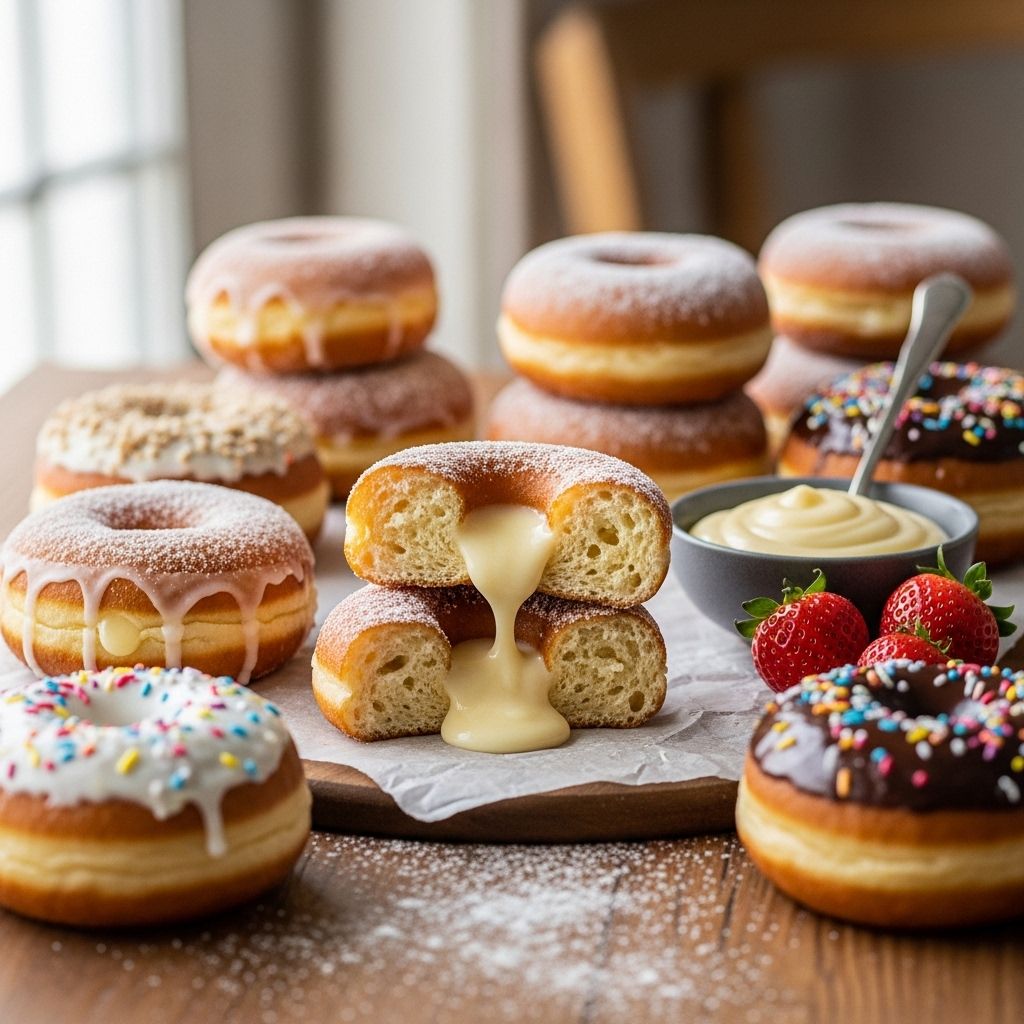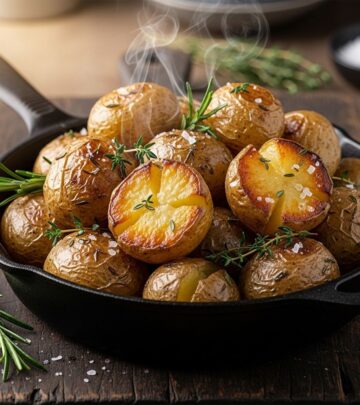Homemade Doughnut Recipe: 8 Steps To Crispy, Creamy Doughnuts
Master the art of homemade doughnuts with this step-by-step guide to making perfectly crispy and creamy treats every time.

Image: HearthJunction Design Team
Crispy and Creamy Doughnuts: The Ultimate Homemade Recipe Guide
If you’ve ever wanted to recreate the irresistible, melt-in-your-mouth doughnuts found in your favorite shops, look no further. This comprehensive guide will walk you through the process of making homemade doughnuts that are both deliciously crispy on the outside and impossibly creamy within. Discover the secrets to enriched dough, perfect proofing, flawless frying, and silky-sweet glaze. No more standing in line at the bakery – these doughnuts are about to become your new favorite treat to make at home.
Ingredients
- 2 (.25 ounce) envelopes active dry yeast
- 1/4 cup warm water (105 to 115°F / 40 to 46°C)
- 1 1/2 cups lukewarm milk
- 1/2 cup granulated white sugar
- 1 teaspoon salt
- 2 eggs
- 1/3 cup butter (melted) or margarine/vegetable shortening
- 5 cups all-purpose flour (plus more for dusting)
- 2 cups confectioners’ sugar (for glaze)
- 1 1/2 teaspoons vanilla extract (for glaze)
- Hot water (as needed, for glaze)
- Oil for deep frying (vegetable, canola, or peanut oil recommended)
Equipment Needed
- Large mixing bowls
- Measuring cups and spoons
- Stand mixer or handheld mixer (optional but helpful)
- Whisk
- Doughnut cutter or round biscuit cutters
- Deep fryer or heavy-bottomed skillet
- Slotted spoon or wide spatula
- Wire racks
- Clean kitchen towels
- Baking sheet or tray (for draining and glazing)
Step-by-Step Doughnut Instructions
1. Activate the Yeast
- Sprinkle the active dry yeast over the warm water in a small bowl.
- Let it sit for 5-10 minutes until it becomes foamy and bubbly, a sign that the yeast is alive and active.
2. Prepare the Enriched Dough
- In a large bowl, combine lukewarm milk, sugar, salt, eggs, and melted butter.
- Mix in the activated yeast mixture.
- Gradually add the flour, 1 cup at a time, mixing well after each addition.
- Once the dough has come together and is no longer sticky, turn it out onto a lightly floured surface.
- Knead the dough gently for about 5-8 minutes, until it is smooth and elastic.
3. First Proof – Let the Dough Rise
- Place the dough into a lightly oiled bowl and cover with a damp cloth or plastic wrap.
- Let it rise in a warm spot until doubled in size, usually about 1 to 1.5 hours.
- Note: Enriched doughs with butter, eggs, and sugar rise more slowly, so be patient for best results.
4. Shape the Doughnuts
- Punch down the risen dough and turn it out onto a floured surface.
- Gently roll the dough to about 1/2-inch (1.25 cm) thickness.
- Use a doughnut cutter or two round cutters (one large for the ring, one small for the hole) to cut out as many doughnuts as possible. Gather and re-roll the scraps to cut more doughnuts.
5. Second Proof – Final Rise
- Place the cut doughnuts and holes onto a lightly floured baking sheet.
- Cover loosely with a clean kitchen towel.
- Allow to rise in a warm spot until doubled in size, about 30-45 minutes.
6. Prepare the Glaze
- While the doughnuts are rising, melt butter in a saucepan over medium heat.
- Stir in confectioners’ sugar and vanilla extract until the mixture is smooth and thick.
- Remove from heat and stir in hot water, one tablespoon at a time, until the glaze is thin enough to coat but not watery.
- Set aside; keep warm for easier dipping later.
7. Fry the Doughnuts
- Heat oil in a deep fryer or heavy skillet to 350°F (175°C) – use a thermometer for accuracy.
- Carefully slide doughnuts into the hot oil using a wide spatula.
- Fry only a few at a time to avoid crowding and cooling the oil.
- Turn doughnuts over as they rise to the surface; fry on each side until golden brown (about 1 minute per side).
- Remove with a slotted spoon and drain on a wire rack placed over a tray or baking sheet.
8. Glaze and Finish
- While still warm, dip the fried doughnuts into the prepared glaze.
- Place glazed doughnuts on a clean wire rack to allow any excess glaze to drip away.
- Let the glaze set before serving for perfectly glossy, sweet doughnuts.
Tips for Perfect Doughnuts Every Time
- Temperature matters: Ensure all wet ingredients are lukewarm, not hot, to avoid killing the yeast.
- Double rise: The double proof (before and after shaping) is crucial for fluffy interiors and crisp exteriors.
- Cut cleanly: Sharp cutters help the doughnuts puff up evenly and avoid deflation.
- Oil temperature: Keep oil at 350°F (175°C) for even frying and to avoid greasy doughnuts. Use a thermometer for best results.
- Fry in batches: Overcrowding drops the oil temperature and leads to uneven cooking.
- Glaze while warm: Dipping warm doughnuts ensures the glaze coats smoothly and sets with a glossy finish.
Nutritional Considerations
- Frying oil retention is estimated at about 10% of the doughnuts’ final weight. Actual values may vary based on oil type, temperature, and frying time.
- For a lighter version, try baking instead of frying, though the signature crispy texture will be different.
Table: Ingredient Overview
| Ingredient | Amount | Purpose |
|---|---|---|
| Active Dry Yeast | 2 packets (0.25 oz each) | Leavening – ensures fluffy rise |
| Warm Water | 1/4 cup | Activates yeast |
| Lukewarm Milk | 1 1/2 cups | Moisture, richness |
| White Sugar | 1/2 cup | Sweetness, feeds yeast |
| Salt | 1 tsp | Balances flavor |
| Eggs | 2 | Enriches dough, texture |
| Butter | 1/3 cup melted | Fat for tenderness, flavor |
| All-purpose Flour | 5 cups | Structure |
| Confectioners’ Sugar | 2 cups | Glaze |
| Vanilla Extract | 1.5 tsp | Flavor in glaze |
| Oil (for frying) | As needed | Creates crispy exterior |
Variations and Customizations
- Chocolate Glaze: Add 2 tablespoons of cocoa powder to the glaze for a chocolatey finish.
- Cinnamon Sugar: Toss fried doughnuts in a mixture of cinnamon and sugar instead of glazing.
- Filled Doughnuts: Skip the hole. Once cooled, fill the doughnut with jam, custard, or cream using a pastry bag.
- Sprinkles: For extra fun, sprinkle colored sugars or nonpareils on top just after glazing.
Storage and Make-Ahead Tips
- Room Temperature: Store glazed doughnuts in an airtight container at room temperature for up to 2 days.
- Freezing: Un-glazed, fried doughnuts can be frozen for up to 2 months. Thaw and glaze before serving.
- Reheating: Warm in a 300°F (150°C) oven for 5 minutes to refresh texture.
Troubleshooting Common Doughnut Issues
- Doughnuts are dense: Under-proofed or too much flour. Allow dough ample time to rise and don’t add excess flour.
- Doughnuts are greasy: Oil temperature too low. Always keep oil at 350°F (175°C).
- Uneven browning: Oil not deep enough or inconsistent temperature. Turn doughnuts and maintain oil depth.
- Glaze too runny/thick: Adjust hot water in the glaze, a spoonful at a time, to reach desired consistency.
Expert Tips from the Editor
Enriched doughs with plenty of sugar, butter, and eggs take longer to rise, which is why using two packets of yeast ensures a reliable, fluffy result. For best glaze results, dip doughnuts while warm so the icing adheres and sets beautifully.
Nutritional note: Oil retention after frying is estimated at about 10%, but can vary due to temperature, cooking time, and type of oil used.
Frequently Asked Questions (FAQs)
Can I use instant yeast instead of active dry yeast?
Yes, you can substitute an equal amount of instant yeast. It may rise a bit faster, so check the dough’s volume rather than the clock.
What’s the best oil for frying doughnuts?
Neutral oils with a high smoke point – like vegetable, canola, or peanut oil – are best for clean flavor and even frying.
How can I tell if the oil is hot enough?
Use a deep-fry or candy thermometer. Alternatively, drop in a doughnut hole; it should rise and bubble within seconds, then brown in about 1 minute.
Can I make the dough ahead?
Yes! After the first rise, cover and refrigerate the dough overnight. Let it come to room temperature and proceed with shaping and frying the next day.
Why are my doughnuts tough?
Over-mixing or adding too much flour can toughen the dough. Knead gently and only add flour as needed to prevent sticking.
Conclusion
With a little patience and these detailed steps, you can create doughnuts that rival the best bakeries – crisp on the outside, creamy and airy inside, and glazed to perfection. This recipe’s double-rise technique and simple but effective glaze make it an ideal base for customization, whether you love a classic sugar doughnut, a chocolate-covered delight, or a jam-filled morning treat. Gather your ingredients, invite some friends or family to help, and enjoy the unbeatable experience of fresh, homemade doughnuts.
References
Read full bio of Srija Burman












